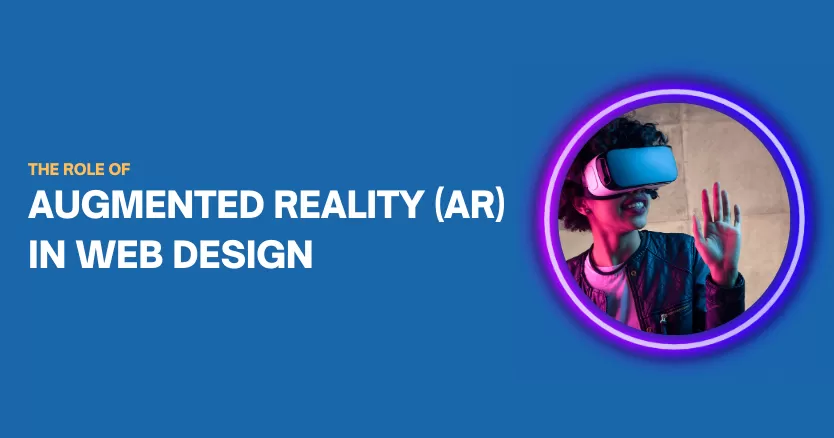
The Role of Augmented Reality (AR) in Web Design
Stepping Into the Augmented Horizon of Web Creativity
Augmented reality (AR) isn’t only for gaming or futuristic films anymore. Now, it’s a powerful tool reshaping how we interact with websites, shaping user experiences and engagement like never before.
It is an insightful exploration of how AR technology and web design are increasingly intertwined. We’ll explore web AR’s multifaceted benefits and technical know-how and look ahead to its exciting future.
You must understand the role of AR in web design, regardless of whether you are an experienced web designer or an aspiring web developer.
AR’s Definition and Impact
Augmented reality involves superimposing digital information, such as images, videos, or 3D models, onto the real world. Users can access it through smartphones, tablets, and even wearable devices, blurring the boundaries between virtual and physical reality.
AR in web design has a vast potential reach due to the widespread use of devices that can run AR applications. AR profoundly impacts UX and UI design, elevating interactivity and user engagement to new levels.
Captivating Examples of AR in Web Design
Websites worldwide are leveraging augmented reality to create captivating user experiences. Consider trying on a dress from an online retailer before you purchase it or visualizing how a piece of furniture would look in your home.
Increasingly, customers can shop online and offline together, resulting in a more fulfilling and informed shopping experience. The use of AR in museums is bringing exhibits to life, while interactive models are revolutionizing education. Using AR, brands work with a marketing agency to create buzz-worthy marketing campaigns that transcend traditional storytelling methods.
AR’s Benefits for Different Website Types
E-commerce and Retail Websites
Virtual Product Try-On
E-commerce sites are making shopping more interactive with AR. Customers can virtually ‘try on’ clothes, accessories, and even makeup, leading to more confident purchase decisions.
Product Visualization
From shoes to heavy machinery, AR allows customers to place the product in their natural environment, helping them visualize their purchase and its spatial requirements before buying.
Interactive Product Exploration
With AR, users can rotate, zoom, and inspect products from all angles, even getting information hotspots for product details, making their online shopping experience as rich as in-store visits.
Educational and Informational Websites
Enhanced Learning Experiences
Educational websites use AR to provide interactive and immersive learning, especially in subjects that benefit from visual aids and 3D models.
Gamified Learning
AR can make even the most mundane topic engaging and fun by introducing game elements, thus enhancing retention and comprehension rates.
Rich Historical or Scientific Context
AR transports visitors to any historical period or supplements scientific concepts with real-world context, presenting information memorably and engagingly.
Marketing and Branding Websites
Interactive Marketing Campaigns
Brands leverage AR to create campaigns that users can participate in, resulting in experiences that leave a mark and ensuring better brand recall and awareness.
Engaging Product Launches
AR helps unveil products in a way that makes a lasting impression, often increasing excitement and pre-purchase interest.
Immersive Brand Storytelling
The power of AR in storytelling is immense. It offers users a narrative that they aren’t just following but also interacting with, ensuring that they become part of the brand’s story.
Technical Considerations of AR Integration in Web Design
Development Tools and Frameworks
Web designers looking to integrate AR into their projects have a spectrum of tools, each with features and learning curves.
Examples of AR Development Tools:
- Unity and Vuforia are used to create 3D models and overlay them onto the camera feed.
- AR.js for lightweight AR experiences on the web without additional app installations.
Device and Browser Compatibility
With the diversity of user devices, ensuring AR experiences run smoothly is a pivotal consideration for developers.
Compatibility Best Practices:
- Use WebXR for browser compatibility.
- Employ responsive design principles to ensure your AR elements fit various screen sizes.
Performance Optimizations
AR applications can be resource-heavy, risking poor user experiences. Addressing performance is critical for smooth operations.
Optimization Techniques:
- Minimize the size and optimize the loading of 3D models.
- Use efficient texture handling methods for visuals.
- Balancing quality with performance to ensure a smooth AR experience across devices.
The Future of AR in Web Design
Advancements and Trend Projections
With technology evolving rapidly, the future of AR in web design is filled with exciting possibilities.
Potential Future Trends:
- Integrating AR in social media platforms could lead to social AR interactions on the web.
- AR Cloud technology promises persistent AR experiences that adapt to the physical environment.
Revolutionizing User Interaction
AR redefines engagement paradigms, creating personalized and context-aware interactions that traditional web design alone cannot offer.
Impact on Web Design Best Practices
The advent of AR presents a challenge to traditional web design paradigms. Web designers need to adapt their techniques to accommodate AR effectively.
Conclusion
The role of AR in web design is set to grow exponentially, offering endless creative opportunities for those willing to explore its potential. It’s not just a passing trend; AR is a defining future for digital experiences that will soon become an expected standard on the web.
By understanding how AR can enhance different types of websites and by keeping an eye on its technical aspects and prospects, web designers and businesses can harness the full power of AR to captivate the online audience like never before.
Whether you’re an entrepreneur considering an AR infusion into your website or a web designer eager to learn more about this exciting realm, the time to engage with AR in web design is now. As you take this augmented leap, remember to keep the user’s experience at the heart of your AR endeavors, ensuring that every augmented addition adds genuine value to their digital interaction.
Don’t just watch this space—augment it with your ideas and creations.
Are you ready to take the first step towards an arrestingly artistic web future? Let’s Connect





